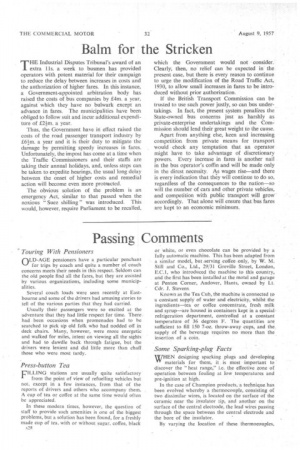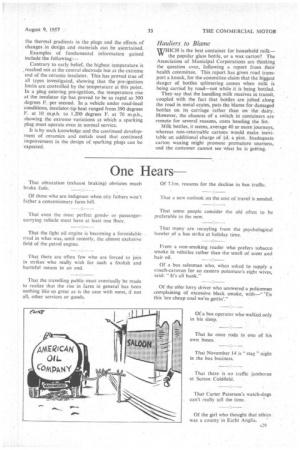Passing Comments
Page 30

Page 31

If you've noticed an error in this article please click here to report it so we can fix it.
Touring With Pensioners
riLD-AGE pensioners have a particular penchant ‘-` for trips by coach and quite a number of coach concerns meets their needs in this respect. Seldom can the old people find all the fares, but they are assisted by various organizations, including some municipalities.
Several coach loads were seen recently at Eastbourne and some of the drivers had amusing stories to tell of the various parties that they. had carried.
Usually their passengers were so excited at the adventure that they had little respect for time. There . had been occasions when promenades had to be searched to pick Up old folk who had nodded off in deck chairs. Many, however, were more energetic and walked for miles, intent on viewing all the sights and had to dawdle back through fatigue, but the drivers were lenient and did little more than chaff. those who were most tardy.
Press-button Tea
FILLING stations are usually quite satisfactory
from the point of view of refuelling vehicles but not, except in a few instances, from that of the reports of drivers and others who accompany them. A cup of tea or coffee at the same time would often be appreciated.
In these modern times, however, the question of staff to provide such amenities is one of the biggest problems, but a solution has been found, for a freshly made cup of tea, with or without sugar, coffee, black k28 or White, or even chocolate can be provided by a fully automatic machine. This has been adapted from a similar model,. but .serving coffee only, by W. M. Still and Co., Ltd., 29/31 Greville Street, London, E.C.1, who introduced the machine to this country, and the first has been installed at the motel and garage at Penton Corner, Andover, Hants, owned by Lt. Cdr, J. Stevens Known as the Tea Cub, the machine is connected to a constant supply of water and electricity, whilst the ingredients—tea or coffee concentrate, fresh milk and syrup—are housed in containers kept in a special refrigeration department, controlled at a constant temperature of 36 degrees F. The quantities are sufficient to fill 150 7-oz. throw-away cups, and the supply of the beverage requires no more than the insertion of a coin.
Some Sparking-plug Facts
\V WHEN designing sparking plugs and developing HEN for them, it is Most important to discover the "heat range," i.e. the effective zone of operation between fouling at low .temperatures and pre-ignition at high.
In the case of Champion products, a technique. has been evolved whereby a thermocouple, consisting of two dissimilar wires, is located on the surface of the ceramic near the insulator tip, and another on the surface of the central electrode, the lead wires passing through the space between the central electrode and the bore of the insulator.
By varying the location of these thermocouples,
the thermal gradients in the plugs and the effects of changes in design and materials can be ascertained. Examples of fundamental information gained include the following:—
Contrary to early belief, the highest temperature is reached not at the central electrode but at the extreme end of the ceramic insulator_ This has proved true of all types investigated, showing that the pre-ignition limits are controlled by the temperature at this point. In a plug entering pre-ignition, the temperature rise at the insulator tip has proved to be as rapid as 300 degrees F. per second, In a vehicle under road-load conditions, insulator-tip heat ranged from 390 degrees F. at JO m.p.h. to 1,200 degrees F. at 70 m.p.h., showing the extreme variations at which a sparking plug must operate even in normal service.
It is by such knowledge and the continued development of ceramics and metals used that continued improvement in the design of sparking plugs can be expected.
Hauliers to Blame
wHicH is the best container for household milk— the popular glass bottle, or a wax carton? The Association of Municipal Corporations are thinking the question over, following a report from their health committee. This report has given road transport a knock, for the committee claim that the biggest danger of bottles splintering comes when milk is being carried by road—not while it is being bottled.
They say that the handling milk receives in transit, coupled with the fact that bottles are jolted along the road in metal crates, puts the blame for damaged bottles on its carriage rather than on the dairy. However, the chances of a switch in containers are remote for several reasons, costs heading the list.
Milk bottles, it seems, average 40 or more journeys, whereas non-returnable cartons would make inevitable an additional charge of 4d. a pint. Inadequate carton waxing might promote premature sourness, and the customer cannot see what he is getting.




























































































